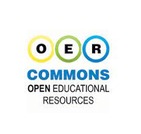
AEK'nda nasıl profil oluşturulur?
- Subject:
- Communication
- Material Type:
- Data Set
- Author:
- Ezgi Erbis
- Date Added:
- 04/05/2021

AEK'nda nasıl profil oluşturulur?
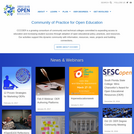
CCCOER is a growing consortium of community and technical colleges committed to expanding access to education and increasing student success through adoption of open educational policy, practices, and resources. Our activities support this dynamic community with information, resources, news, projects and building connections.
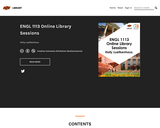
This resource is used to provide library instruction for introductory undergraduate composition courses.
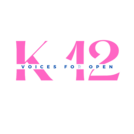
The Educator & Staff Professional Learning Plan is one component of the K-12 Voices for Open OER - DEIA Action Planning Guide. This plan, and the entire guide, is intended as a strategic planning tool for district leaders wishing to promote the already pedagogically and financially compelling practice of creating or adapting open educational resources (OER) to help achieve district goals in serving all students through diversity, equity, inclusion, or accessibility (DEIA) lens. The guide provides step-by-step planning tools, including examples, templates, and resources to help district leaders articulate and establish action plans for what we refer to as "OER-DEIA." The entire guide is an open educational resource itself, free and openly licensed for reuse, remixing, and resharing.
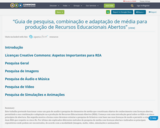
Este trabalho pretende funcionar como um guia de auxílio à pesquisa de elementos de média que constituam objetos de conhecimento com licenças abertas, permitindo a sua combinação e adaptação na a produção de Recursos Educacionais Abertos (REA).
Começa com uma introdução geral sobre os REA e os cinco princípios de abertura. Em seguida mostra a forma como devemos orientar a pesquisa de ficheiros com base nas suas licenças de modo a permitir a criação dum REA que respeite os cinco Rs.
Por último são explicados diferentes métodos de pesquisa de média com licenças abertas e indicados os principais repositórios onde podem ser encontrados, de acordo com a modalidade (imagem, áudio, vídeo, simulações e animações).
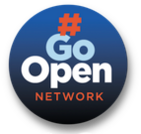
On April 18, 2023, #GoOpen held a public webinar titled, "Integrating OER into Instructional Initiatives." The session featured Rebecca Henderson, Curriculum Services Supervisor, Westmoreland Intermediate Unit, PA; Tracy Rains, Virtual Learning Specialist, Appalachia Intermediate Unit 8, PA; and, Kelly Hammond, OER and Open Pedagogy Adjunct, CUNY School of Professional Studies; and facilitator, Amee Evans Godwin of ISKME and the #GoOpen National Network.
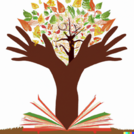
This image was generated with DALL-E AI for a presentation about Knowledge Equity and Open Education in March 2023. It has been used several times to illustrate the ideas behind sharing knowledge openly.
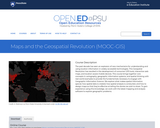
The past decade has seen an explosion of new mechanisms for understanding and using location information in widely-accessible technologies. This Geospatial Revolution has resulted in the development of consumer GPS tools, interactive web maps, and location-aware mobile devices. This course brings together core concepts in cartography, geographic information systems, and spatial thinking with real-world examples to provide the fundamentals necessary to engage with Geographic Information Science. We explore what makes spatial information special, how spatial data is created, how spatial analysis is conducted, and how to design maps so that they're effective at telling the stories we wish to share. To gain experience using this knowledge, we work with the latest mapping and analysis software to explore geographic problems.
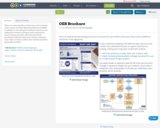
There are many benefits to instructors and to students when courses use Open Educational Resources (OER).
In addition to cost savings for students, instructors are finding that students read open online textbooks in more locations and more often than previously-purchased textbooks. Instructors can also customize open online content to reflect their students (and their geographic location).
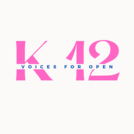
This guide is intended as a strategic planning tool for district leaders wishing to promote the already pedagogically and financially compelling practice of creating or adapting open educational resources (OER) to help achieve district goals in serving all students through diversity, equity, inclusion, or accessibility (DEIA) lens. The guide provides step-by-step planning tools, including examples, templates, and resources to help district leaders articulate and establish action plans for what we refer to as "OER-DEIA." The entire guide is an open educational resource itself, free and openly licensed for reuse, remixing, and resharing.

Digital learning is the vital tool for facilitating the teaching learning process. The article gives the current scenario and SWOT analysis of the digital learning in higher education.
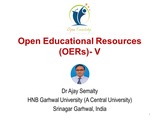
The Topic introduces various OER repositories in India including the SWAYAM. It also focus the challenges and tips for adopting OERs for beginners.

The links within this resource are designed to provide educators with background context regarding the development of the K-12 Voices for Open OER-DEIA Action Plan for K-12 District Implementation. Presented as a poster session at the 2022 OpenEd Conference, the slides explain the purpose of the Guide, as well as the development process.This guide is intendend as a strategic planning tool for district leaders wishing to promote the already pedagogically and financially compelling practice of creating or adapting open educational resources (OER) to help achieve district goals in serving all students through diversity, equity, inclusion, or accessibility (DEIA) lens. The guide provides step-by-step planning tools, including examples, templates, and resources to help district leaders articulate and establish action plans for what we refer to as "OER-DEIA." The entire guide is an open educational resource itself, free and openly licensed for reuse, remixing, and resharing.

This poster helps to explain the development process of the OER-DEIA Guide developed by K-12 Voices for Open, which can also be found on OER Commons.
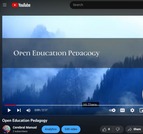
A short introduction video about open education pedagogy for simple education purposes. The goal is to help educational organizations increase inclusivity, belonging, equity and diversity. This is done by designing curriculum with the student, instead of for the student.

Pressbooks is an Open Textbook platform. This Open (Canvas LMS) course demonstrates various methods of placing an open Pressbooks textbook in Canvas, including as a Navigation menu item and as links, PDFs or pages within Modules. It also includes various methods of providing students with a print version.

Short video providing an introduction to US Copyright.

This module provides faculty in higher education with an introduction to the use and creation of Open Educational Resources. It is intended for faculty who are new to the principles of Open Education. Several of the examples in this module relate to higher education in Canada, but you are encouraged to adapt the resources you suit your context.It can be used as part of a course on open education and would benefit from an expanded discussion of Open Pedagogy, an additional module on Open Access, and a module on Developing Open Policies for higher education institutions.

This template is part of the K-12 Voices for Open OER-DEIA Action Plan for K-12 District Implementation. The template, and the entire guide, is intendend as a strategic planning tool for district leaders wishing to promote the already pedagogically and financially compelling practice of creating or adapting open educational resources (OER) to help achieve district goals in serving all students through diversity, equity, inclusion, or accessibility (DEIA) lens. The guide provides step-by-step planning tools, including examples, templates, and resources to help district leaders articulate and establish action plans for what we refer to as "OER-DEIA." The entire guide is an open educational resource itself, free and openly licensed for reuse, remixing, and resharing.

This template is part of the K-12 Voices for Open OER-DEIA Action Plan for K-12 District Implementation. The template, and the entire guide, is intendend as a strategic planning tool for district leaders wishing to promote the already pedagogically and financially compelling practice of creating or adapting open educational resources (OER) to help achieve district goals in serving all students through diversity, equity, inclusion, or accessibility (DEIA) lens. The guide provides step-by-step planning tools, including examples, templates, and resources to help district leaders articulate and establish action plans for what we refer to as "OER-DEIA." The entire guide is an open educational resource itself, free and openly licensed for reuse, remixing, and resharing.